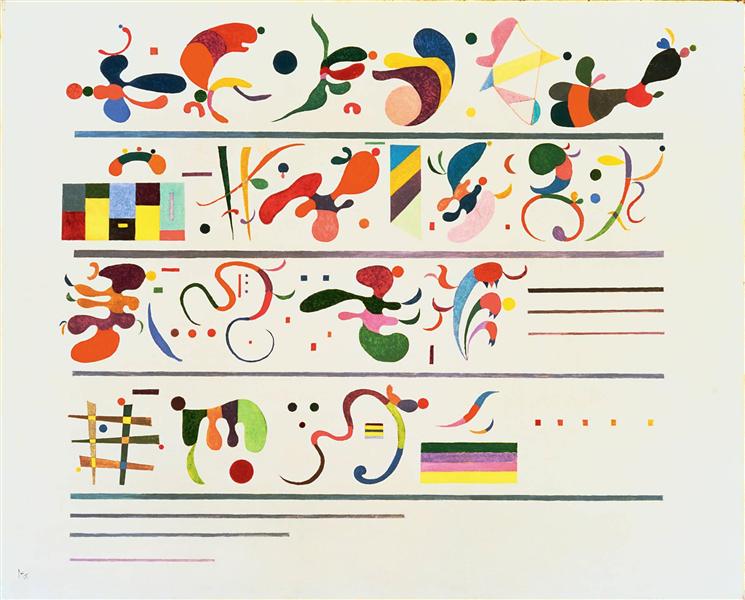Description
The work "Succession" (1935) by Wassily Kandinsky is a sublime example of the evolution of abstract language that the artist perfected throughout his career. This painting, like many of its creations, challenges the traditional conventions of figurative art and reveals the deep connection between color, shape and emotion, central elements of Kandinsky's approach to painting.
In "Succession", a vibrant range of colors is displayed on the canvas, where you can see tones of blue, red, yellow and black, which are intertwined in a complex plot of abstract shapes. The composition seems to be in constant movement, suggesting a dynamic of transition and change. Kandinsky, following its own color theory, uses these nuances not only as visual elements, but as carriers of meaning and emotions. Each color becomes a symbol that evokes sensory and spiritual responses, characteristics of its careful interest in synesthesia; The interrelation between the senses that, for him, was fundamental in the art experience.
By carefully observing "succession", the meticulous attention that the artist provides at the disposal of the elements in the painting. The geometric and organic shapes perform a subtle dialogue with each other, creating a visual hierarchy that leads the viewer to travel the canvas almost musical. That feeling of rhythm and cadence is something that Kandinsky worked hard; You can distinguish the intention that each section of the work contributes to a general harmony, evoking the experience of a musical ensemble rather than the traditional visual narrative.
Contrary to works of his early stage, in which he sought to represent reality in a more literal and figurative way, "succession" is registered within the artist's maturity, where total abstraction is found not only as an aesthetic act but also as A path to interiority and spirituality. In this sense, the use of forms that suggest movements or pulsations can be interpreted as a reflection of the cyclical nature of life and art itself.
It is interesting to observe that this work, created during its period in Germany, reflects the cultural and artistic context of the time. Kandinsky was a pioneer of abstract art and, along with other avant -garde, sought to break barriers to artistic representation. This search resonated with the contemporary concerns of society, marked by political instability and constant change. Kandinsky's abstraction served as a means to explore subjectivity and to challenge established aesthetic standards.
"Succession" is thus aligned not only with Kandinsky's personal legacy, but also with a broader tradition within modernism that would seek new meanings in the specificity of color and shape. In the reflection that this work leaves, we find an invitation to understand art as a phenomenon that transcends its own materiality, proposing a space where the viewer can come into contact with its own emotions and sensibilities.
In the end, "succession" is not simply a painting; It is an artistic phenomenon that allows the limitations of time and space to transcend, offering each observer the opportunity to explore glows of creation through abstraction, an open door towards inner reflection and pure aesthetic experience. With this work, Kandinsky not only establishes a lasting legacy, but also invites each of us to a continuous dance between perception and emotion, reminding us that art, in its purest form, is always a succession of unforgettable experiences .
KUADROS ©, a famous paint on your wall.
Hand-made oil painting reproductions, with the quality of professional artists and the distinctive seal of KUADROS ©.
Art reproduction service with satisfaction guarantee. If you are not completely satisfied with the replica of your painting, we refund your money 100%.

